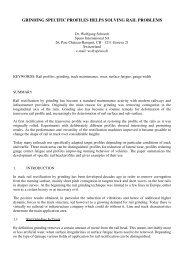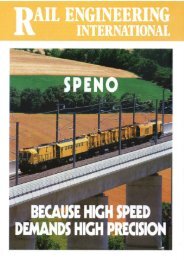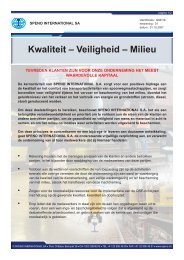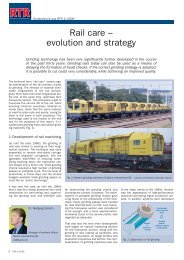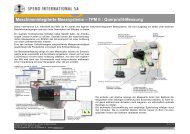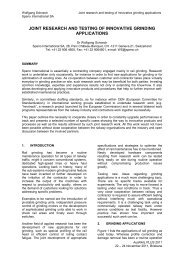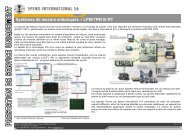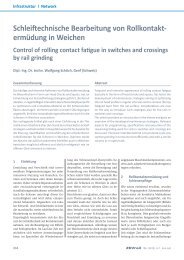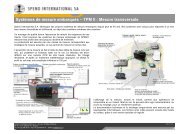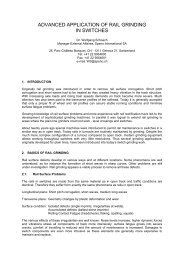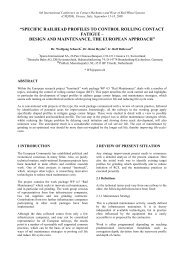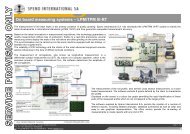Rolling Contact Fatigue mitigation by grinding - speno international sa
Rolling Contact Fatigue mitigation by grinding - speno international sa
Rolling Contact Fatigue mitigation by grinding - speno international sa
Create successful ePaper yourself
Turn your PDF publications into a flip-book with our unique Google optimized e-Paper software.
This approach allows controlled <strong>grinding</strong> cycles that balance crack growth, metal removal and<br />
maintenance intervals in an acceptable compromise that is advantageous.<br />
Grinding work can be specified as follows:<br />
• Metal removal in fatigued zone to a depth between 0.2 and 0.6 mm<br />
• Target profile (wear-adapted) within acceptable tolerances (-0.6 mm maximum)<br />
With modern <strong>grinding</strong> equipment complete headcheck removal is possible. Bigger machines can effect<br />
even one-pass-<strong>grinding</strong> with production rates that reduce traffic disturbances and artificial wear. Onboard<br />
headcheck measuring systems is required to control exactly the defect elimination while limiting<br />
metal removal.<br />
3.3.3 Corrective actions<br />
Of course it is not possible to grind all new rails, and <strong>grinding</strong> cycles cannot always be programmed to<br />
avoid more severe defect situations. Thus when starting a campaign many kilometers of track may be<br />
in different stages of fatigue from medium to very severe.<br />
In these cases, apart from changing rails heavily affected <strong>by</strong> fatigue, corrective <strong>grinding</strong> may prove<br />
economically justified. Rails with completely removed headchecks can serve for another long period,<br />
provided that there is a subsequent series of cyclical interventions.<br />
Grinding work can be specified as follows:<br />
• Metal removal from 0.6 mm up to 3 mm (estimated maximum value for economic reasons)<br />
• Wear-adapted target profile with only negative tolerances (-1.0 mm maximum)<br />
Heavy duty <strong>grinding</strong> equipment is recommended in order to limit the number of <strong>grinding</strong> passes.<br />
Milling and planing can provide useful alternatives. Monitoring of crack depths should be available to<br />
check that cracks are completely removed. If cracks cannot be completely removed in one intervention<br />
due to limited track possession time, a gradual corrective approach can be envi<strong>sa</strong>ged, with<br />
subsequent corrective actions planned well before defect growth deteriorates again.<br />
3.3.4 Recommended actions<br />
As all <strong>grinding</strong> strategies depend on many parameters, only guide-lines can be given. Actions will<br />
depend on local traffic and track characteristics that influence fatigue development together with<br />
operational aspects.<br />
In a simplified summary: a controlled <strong>grinding</strong> action is best when the process can remove in a onepass-action<br />
just the existing defect depth while simultaneously correcting the transverse profile.<br />
As a representative figure, a cyclical metal removal, of 0.3 to 0.4mm (corresponding to some 30 to<br />
40 MGT for rail grade R260, or every second year on an average conventional line) can be expected.<br />
As harder rails show a reduced fatigue development the <strong>grinding</strong> intervals may be respectively longer,<br />
while maintaining the <strong>sa</strong>me metal removal rates.<br />
3.4 Grinding rails in turnouts<br />
Surface fatigue concerns not only on open track but in turnouts as well. Track components there are<br />
particularly sensitive to surface damage. Running from stock-rails to switch blades and over frogs,<br />
usually mobile ones, always implies higher dynamic forces and lateral movements. Squats on swing<br />
nose frogs and headchecks on turnout rails have been observed frequently.<br />
Many railways have adopted rail <strong>grinding</strong> in turnouts. Of particular importance is to maintain the ideal<br />
railhead profile also over the turnout area. As-inclined railhead profiles on vertically mounted rails are<br />
standard today. Even anti-headcheck profiles in switches have been tested successfully.




